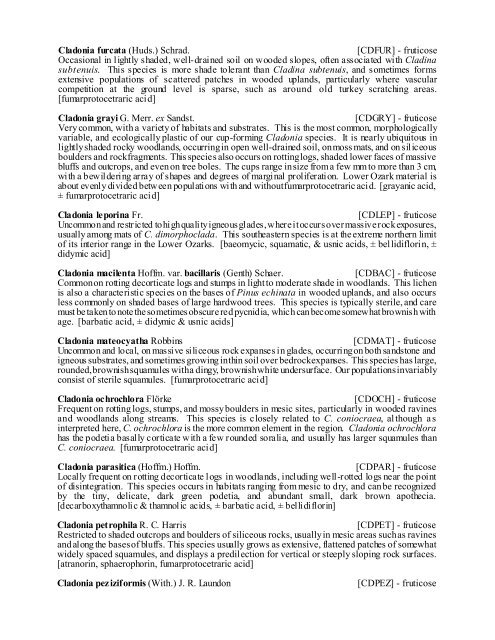lichens of the lower ozark region of missouri and arkansas
lichens of the lower ozark region of missouri and arkansas
lichens of the lower ozark region of missouri and arkansas
Create successful ePaper yourself
Turn your PDF publications into a flip-book with our unique Google optimized e-Paper software.
Cladonia furcata (Huds.) Schrad. [CDFUR] - fruticose<br />
Occasional in lightly shaded, well-drained soil on wooded slopes, <strong>of</strong>ten associated with Cladina<br />
subtenuis. This species is more shade tolerant than Cladina subtenuis, <strong>and</strong> sometimes forms<br />
extensive populations <strong>of</strong> scattered patches in wooded upl<strong>and</strong>s, particularly where vascular<br />
competition at <strong>the</strong> ground level is sparse, such as around old turkey scratching areas.<br />
[fumarprotocetraric acid]<br />
Cladonia grayi G. Merr. ex S<strong>and</strong>st. [CDGRY] - fruticose<br />
Very common, with a variety <strong>of</strong> habitats <strong>and</strong> substrates. This is <strong>the</strong> most common, morphologically<br />
variable, <strong>and</strong> ecologically plastic <strong>of</strong> our cup-forming Cladonia species. It is nearly ubiquitous in<br />
lightly shaded rocky woodl<strong>and</strong>s, occurring in open well-drained soil, on moss mats, <strong>and</strong> on siliceous<br />
boulders <strong>and</strong> rock fragments. This species also occurs on rotting logs, shaded <strong>lower</strong> faces <strong>of</strong> massive<br />
bluffs <strong>and</strong> outcrops, <strong>and</strong> even on tree boles. The cups range in size from a few mm to more than 3 cm,<br />
wi th a bewildering array <strong>of</strong> shapes <strong>and</strong> degrees <strong>of</strong> marginal proliferation. Lower Ozark material is<br />
about evenly divided betw een populati ons with <strong>and</strong> without fumarprotocetraric acid. [grayanic acid,<br />
± fumarprotocetraric acid]<br />
Cladonia leporina Fr. [CDLEP] - fruticose<br />
Uncommon <strong>and</strong> restr icted to high quality igneous glades, where it occurs over massive rock exposures,<br />
usually among mats <strong>of</strong> C. dimorphoclada. This sou<strong>the</strong>astern species is at <strong>the</strong> extreme nor<strong>the</strong>rn limit<br />
<strong>of</strong> its interior range in <strong>the</strong> Lower Ozarks. [baeomycic, squamatic, & usnic acids, ± bellidiflorin, ±<br />
didymic acid]<br />
Cladonia macilenta H<strong>of</strong>fm. var. bacillaris (Genth) Schaer. [CDBAC] - fruticose<br />
Common on rotting decorticate logs <strong>and</strong> stumps in light to moderate shade in woodl<strong>and</strong>s. This lichen<br />
is also a characteristic species on <strong>the</strong> bases <strong>of</strong> Pinus echinata in wooded upl<strong>and</strong>s, <strong>and</strong> also occurs<br />
less commonly on shaded bases <strong>of</strong> large hardwood trees. This species is typically sterile, <strong>and</strong> care<br />
must be taken to note <strong>the</strong> sometimes obscure red pycnidia, which can become somewhat brownish with<br />
age. [barbatic acid, ± didymic & usnic acids]<br />
Cladonia mateocyatha Robbins [CDMAT] - fruticose<br />
Uncommon <strong>and</strong> local, on massive siliceous rock expanses in glades, occurring on both s<strong>and</strong>stone <strong>and</strong><br />
igneous substrates, <strong>and</strong> sometimes growing in thin soil over bedrock expanses. This species has large,<br />
rounded, brownish squamules with a dingy, brownish white undersurface. Our populations invariably<br />
consist <strong>of</strong> sterile squamules. [fumarprotocetraric acid]<br />
Cladonia ochrochlora Flörke [CDOCH] - fruticose<br />
Frequent on rotting logs, stumps, <strong>and</strong> mossy boulders in mesic sites, particularly in wooded ravines<br />
<strong>and</strong> woodl<strong>and</strong>s along streams. This species is closely related to C. coniocraea, al though a s<br />
interpreted here, C. ochrochlora is <strong>the</strong> more common element in <strong>the</strong> <strong>region</strong>. Cladonia ochrochlora<br />
has <strong>the</strong> podeti a basally corticate w ith a few rounded soralia, <strong>and</strong> usually has larger squamules than<br />
C. coniocraea. [fumarprotocetraric acid]<br />
Cladonia parasitica (H<strong>of</strong>fm.) H<strong>of</strong>fm. [CDPAR] - fruticose<br />
Locally frequent on rotting decorticate logs in woodl<strong>and</strong>s, including well-rotted logs near <strong>the</strong> point<br />
<strong>of</strong> disintegration. This species occurs in habitats ranging from mesic to dry, <strong>and</strong> can be recognized<br />
by <strong>the</strong> tiny, delicate, dark green podetia, <strong>and</strong> abundant small, dark brown apo<strong>the</strong>cia.<br />
[decarboxythamnolic & thamnol ic acids, ± barbatic acid, ± bellidiflorin]<br />
Cladonia petrophila R. C. Harris [CDPET] - fruticose<br />
Restricted to shaded outcrops <strong>and</strong> boulders <strong>of</strong> siliceous rocks, usually in mesic areas such as ravines<br />
<strong>and</strong> along <strong>the</strong> bases <strong>of</strong> bluffs. This species usually grows as extensive, flattened patches <strong>of</strong> somewhat<br />
widely spaced squamules, <strong>and</strong> displays a predilection for vertical or steeply sloping rock surfaces.<br />
[atranorin, sphaerophorin, fumarprotocetraric acid]<br />
Cladonia pez iziformis (With.) J. R. Laundon [CDPEZ] - fruticose


